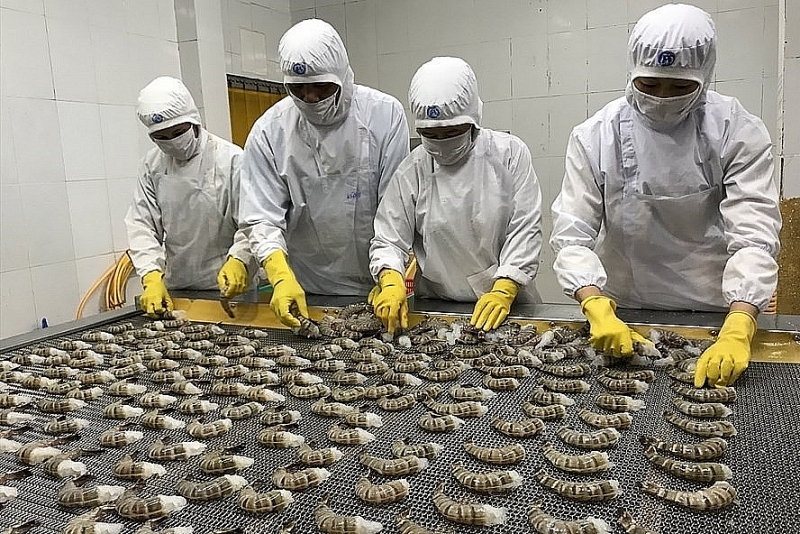Seafood exporters need to strictly control hygiene and sterilization
Seafood businesses are facing strict control hygiene and sterilization regulations, especially during the loading and unloading stage in order to minimize shipments that may suffer from indicators related to Covid-19.
 |
|
Shrimp processing for export. Photo: N.H |
China is Vietnam's sixth largest shrimp import market, accounting for 6% of the total. Vietnam's shrimp exports to China this year are expected to recover after a decline last year.
In 5 years (2016-2020), Vietnam's shrimp exports to China increased from US$436 million in 2016 to US$526 million in 2020, up 21% with an average growth rate of 9%. However, in 2021, shrimp exports to this market reached only US$412.4 million, down 22% compared to 2020.
In 2021, China implemented strict controls on imports due to the impact of the Covid-19 pandemic.
In particular, China has suspended the imports of many companies from India, Ecuador and some Asian countries. China has shifted to promote domestic consumption instead of importing.
Moreover, they pursue a "zero Covid" policy, which strictly controls the Covid-19 pandemic at China's import ports by air, sea and border, hindering shrimp exports from Vietnam to China last year.
As of February 15, 2022, Vietnam's shrimp exports to China reached nearly $23 million, down 7.4% year on year. Exports at the beginning of the year did not soar, the rate of decline was lower than the decline of last year.
Vietnam's shrimp exports to China this year are expected to recover as China begins to relax strict import controls.
Some Vietnamese companies export a lot of shrimp to China such as Mai Son Seafood Co., Ltd., Linh Phat Seafood Service and Trading Co., Ltd., Anh Nhan Trading Production One Member Co., Ltd., and Hoang Ha International Logistics Joint Stock Company.
The main shrimp products exported to China include frozen fresh HOSO Penaeus monodon, semi-block frozen whole boiled Penaeus monodon, frozen whole Penaeus monodon, frozen headless and shelled white shrimp, and headless and peeled frozen Litopenaeus vannamei, frozen fresh headless, peeled and tailed vannamei (PD), frozen semi-blocked whole boiled vannamei, frozen fresh PUD, frozen shelled headless shrimp IQF.
China is one of the world's largest shrimp-consuming markets with huge food service channels. In 2022, China's shrimp imports are forecast to increase sharply, especially when a large shrimp supply to China, Ecuador, is planning to regain market share in the Chinese market after a decline in 2020 and 2021 due to the detection of coronavirus on product packaging.
China's shrimp imports increased from $1.4 billion in 2018 to $3.7 billion in 2021. In 2021, China's imports of frozen warm-water shrimp increased 12% to 611,000 tons. Vietnam is the fourth largest shrimp supplier to this market after Ecuador, India and Thailand.
China's regulations and barriers are still strict, especially given the time when China's Customs authorities are tightening supervision of imported food products during the Covid-19 pandemic. Therefore, it is high time for Vietnamese businesses to strictly control hygiene and disinfection, especially during the loading and unloading stage to minimize shipments that may be in danger of indicators related to Covid-19.
Recently, the Agro-Forestry-Fisheries Quality Assurance Department (NAFIQAD) also asked seafood processing enterprises exporting to China to strictly comply with regulations.
In particular, it is required that business leaders are aware of the importance of Covid-19 control and prevention in the process of producing and exporting seafood to China. They also direct relevant departments to fully implement Covid-19 prevention measures under the direction of the Government, the Ministry of Health, and the guidance of FAO and WHO.
At the same time, businesses focus on a number of control measures, such as requiring people participating in the packaging, loading and unloading stages of finished products, entering and leaving the warehouse, loading and unloading containers to wear masks, regularly disinfect hands and get screened periodically.
Research, reference and application of "Guidelines (updated) on prevention and sterilization techniques for SARS-CoV-2 virus for cold-preserved food production and trading establishments" which is newly issued together with note No. (2022)55 dated February 15, 2022 of the Food Safety Administration, General Administration of Customs of China.








